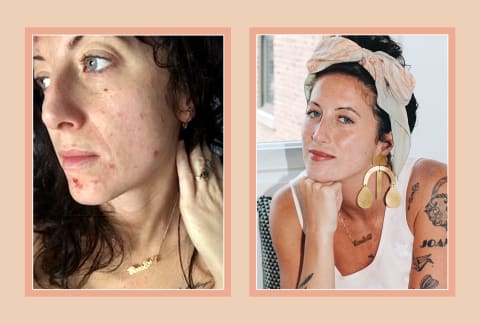Personally, I’ve had a skin obsession since I was young.
It wasn’t always in the form of picking.
I have a fair amount of moles and was incredibly self-conscious about them as a kid.

My mom was vocal about her own struggle with “bad skin” and how frustrating it was.
She’d be hyper-focused on it.
She was constantly looking for the next product to help her.

She continues to be vocal about her skin and products she’s using.
While growing up, I subconsciously took cues from her obsession.
Once I got sober in 2009, picking my face became my addiction of choice.
Before I was sober, I certainly went through phases of picking.
For instance, in college, I would over-pluck my eyebrows.
But my facial picking didn’t become a full-fledged obsession until I stopped drinking.
Dermatillomania and trichotillomania are what’s known as body-focused repetitive behaviors, or “BFRBs” for short.
As the picking started to take off, I wasn’t aware of the terminology for a long time.
To be honest, I just thought I had really bad skin.
I’d think, “What’s wrong; why can’t I find the right treatment?”
Traveling happens to be a trigger for me.
I had a really bad episode of picking two and a half years ago when I was on vacation.
I remember waking up with painful scabs on my face and putting makeup on because I felt super self-conscious.
I got totally out of hand.
I spent that whole vacation isolating.
My face was in pain, with literal open wounds.
What started out as a few minor blemishes, which would have gone unnoticed, became painful sores andscars.
It was physically and emotionally painful and exhausting.
I was feeling so alone.
At this point, I recognized my picking for what it was: a very specific brand of self-harm.
So I started Googling support groups.
I didn’t feel like I was in control.
So I figured I’d give one a try.
I found a group for BFRBs, and it was exactlywhat I needed.
The other people in the group had behaviors similar to mine, including the level of obsession.
In group we worked on checking expectations of ourselves and holding ourselves back from doing certain things.
I immediately felt much less alone and really connected to these people.
One of the best things I did to stop picking was to change my self-talk about my skin.
Here’s the thing: Nobody’s skin is perfect.
We’re human; we’re flawed; this is who we are.
In my fantasy, I’m airbrushed at all times.
It’s so unreasonable!
Even after going to the support group, I was still struggling with picking.
I realized I needed more support.
Last year, I found out aboutAnnette Pasternak, who does online coaching through Skype.
Working with her has been game-changing.
I absolutely think that self-care and having a spiritual practice have helped.
I’m retraining my brain out of that stuff.
What’s coming up for you?
It has been immensely helpful.
And of course, there are practical things and physical barriers that are absolutely necessary.
It’s a dissociative state and kind of relaxing.
Some people tape their fingers.
I teach yoga, so I often look tobreathworkand breathing techniques too.
They can change my state quickly.
I also keep my bathroom mirror completely covered at all times.
Thankfully, my husband is encouraging and supportive.
We have a towel over the mirror that is binder clipped to it.
I need tangible barriers.
PuttingManuka honeyon my skin has helped, too, because it’s healing and sticky.
At the end of the day, it’s all about habit.
Even still, I struggle.
It’s become a daily practice of trying to be good to myself.
I didn’t realize skin picking was an emotional coping mechanism until I was really injuring myself.
In that way it led to a bizarre relationship with my body, one that’s so compartmentalized.
I think it’s potentially similar in nature to eating disorders.
Ultimately, I want to get to a place where I just don’t give a shit.
I’m tired of giving so much of a shit for things that don’t serve me.
That’s where I want to be.
It’s a daily practice, it really is.